
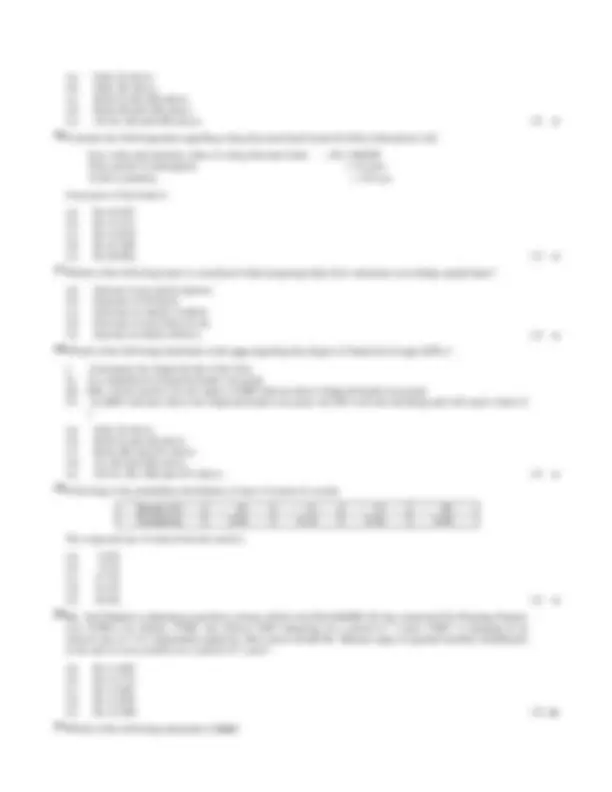
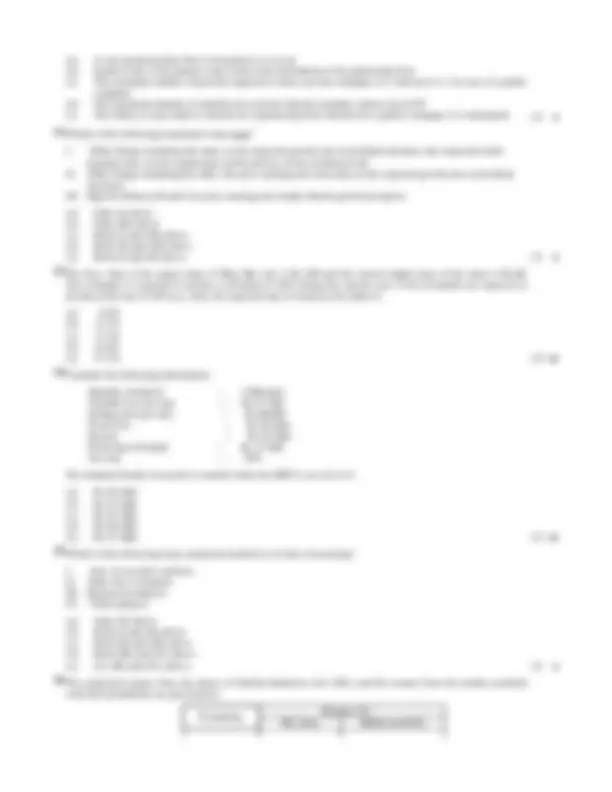
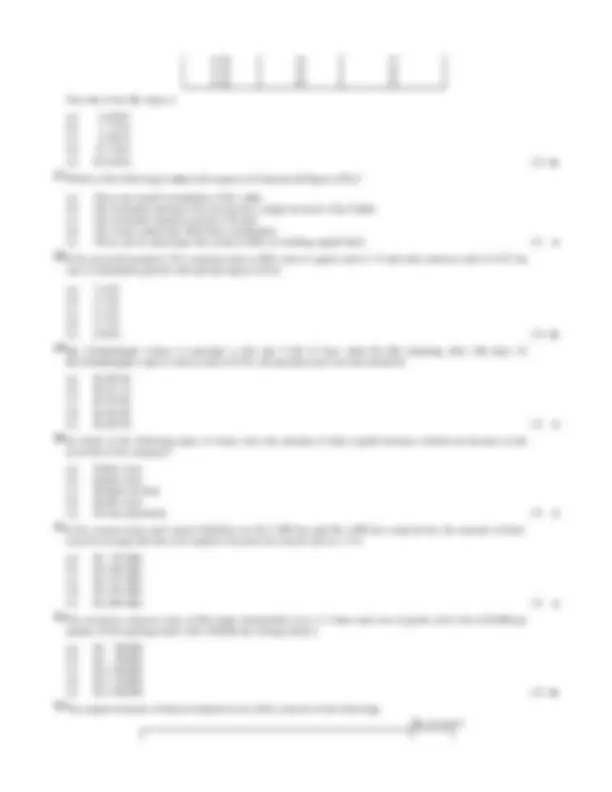
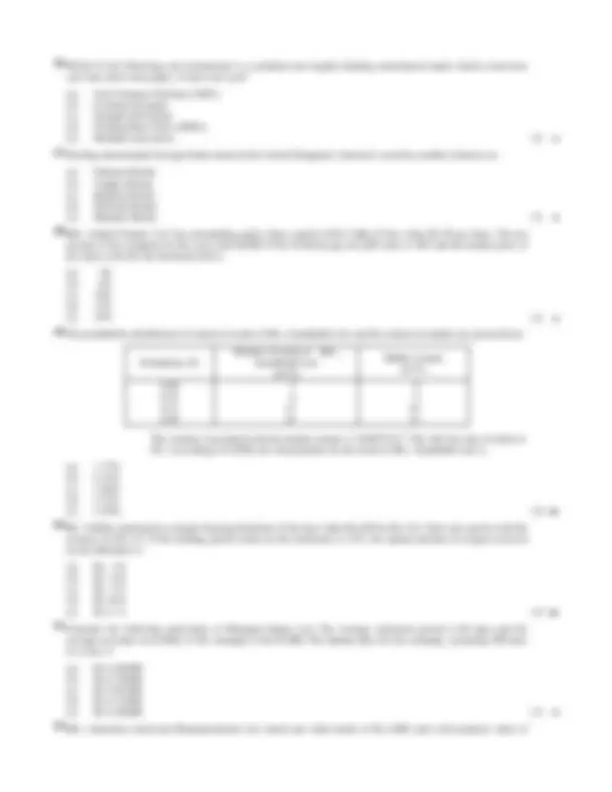
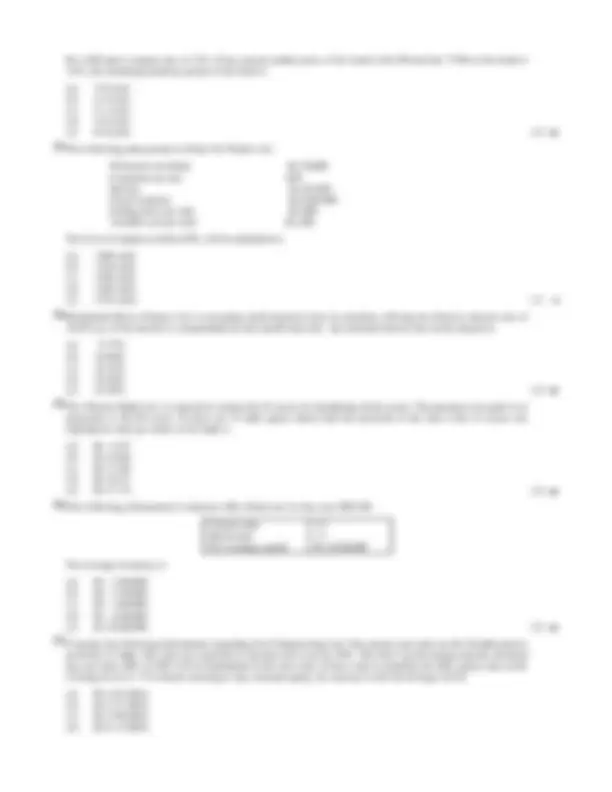
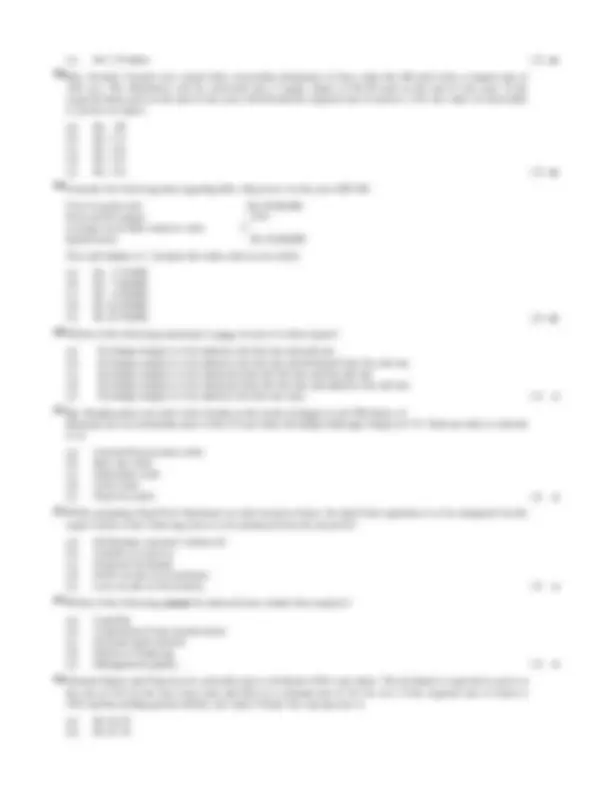
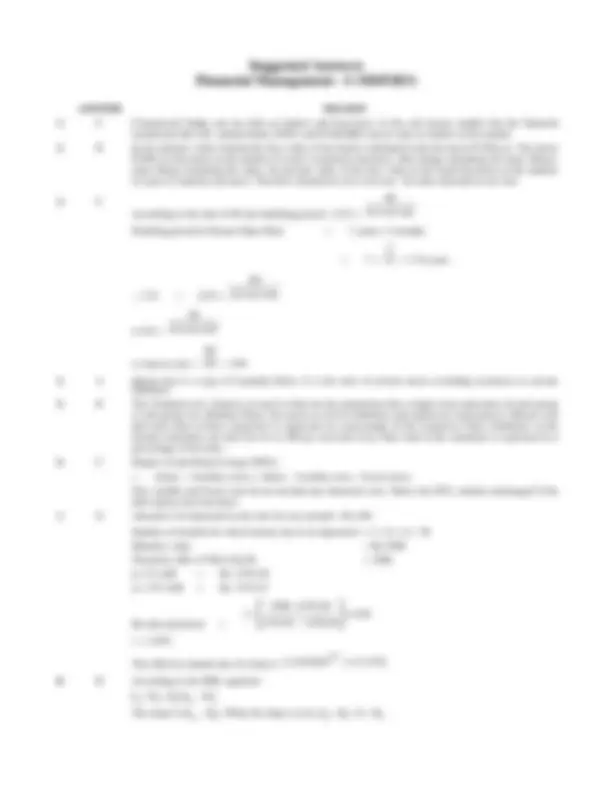
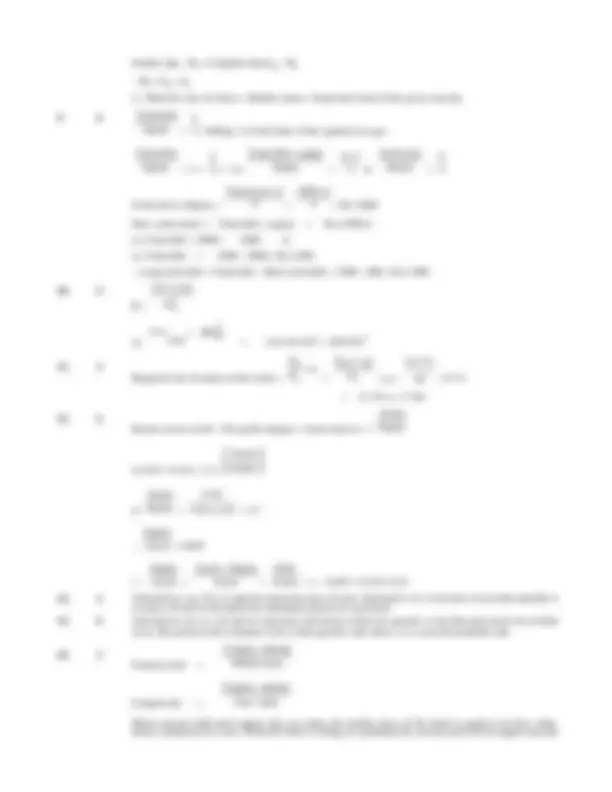
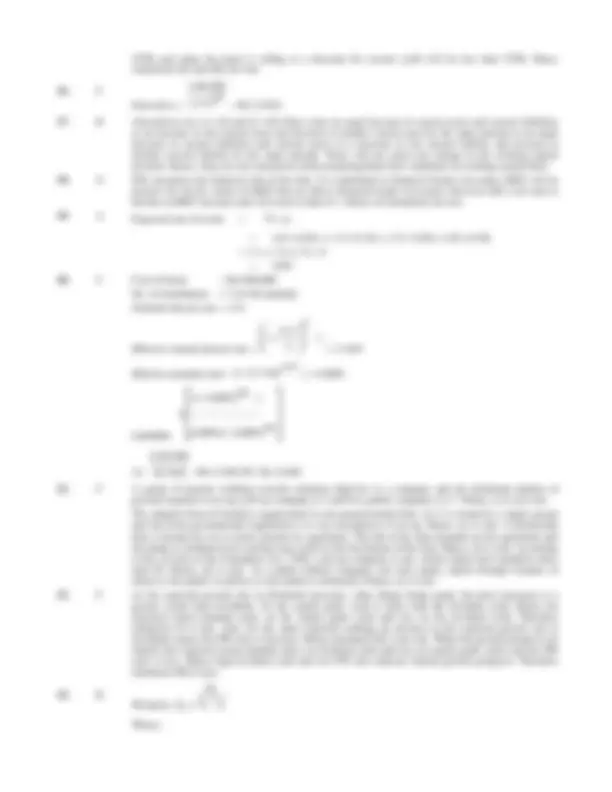
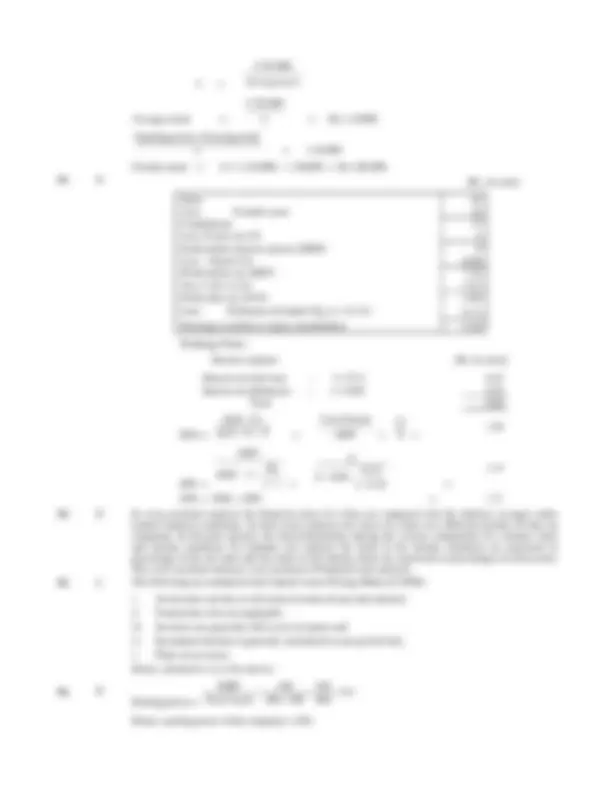
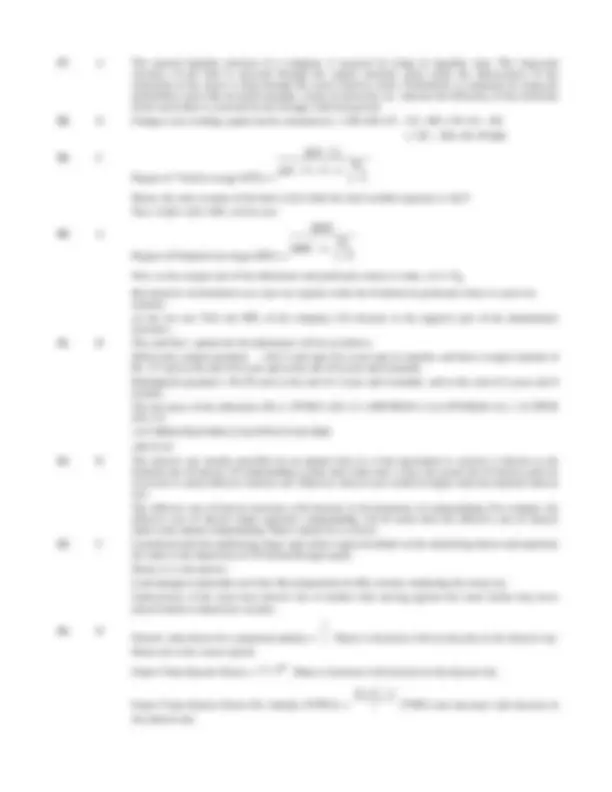
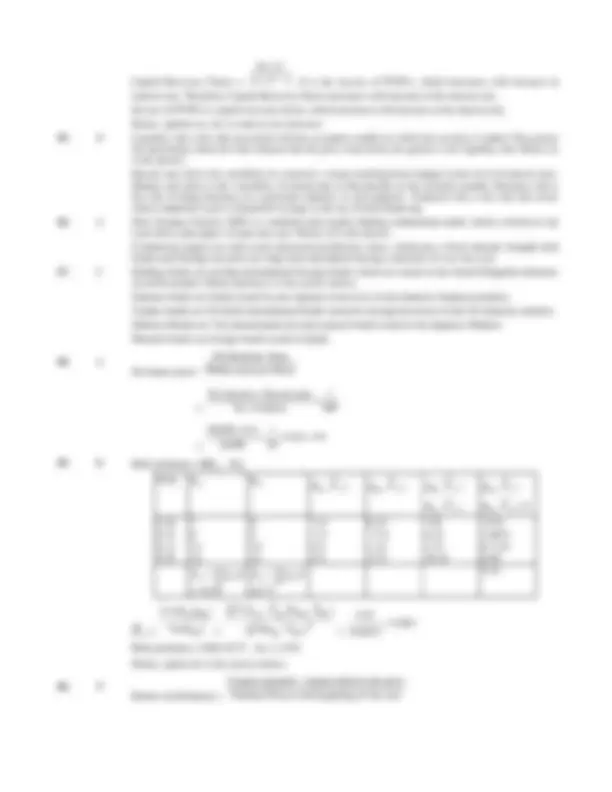
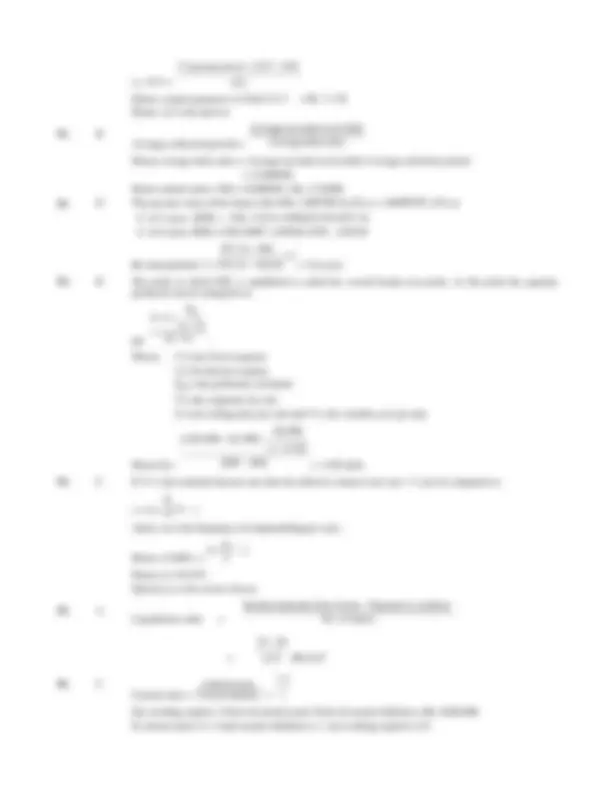
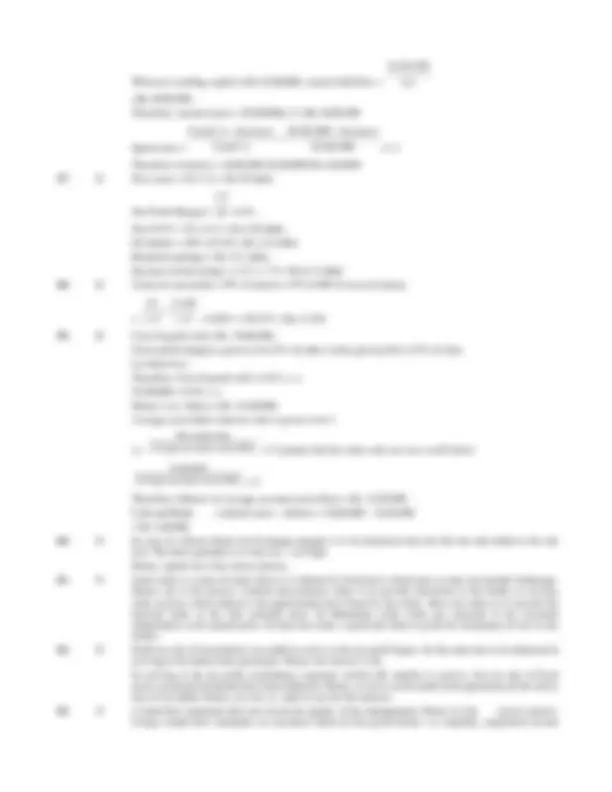
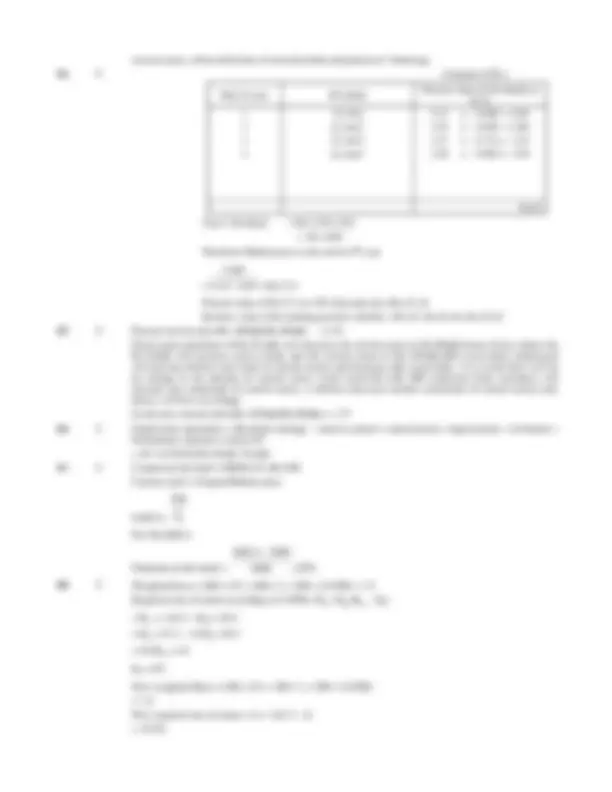
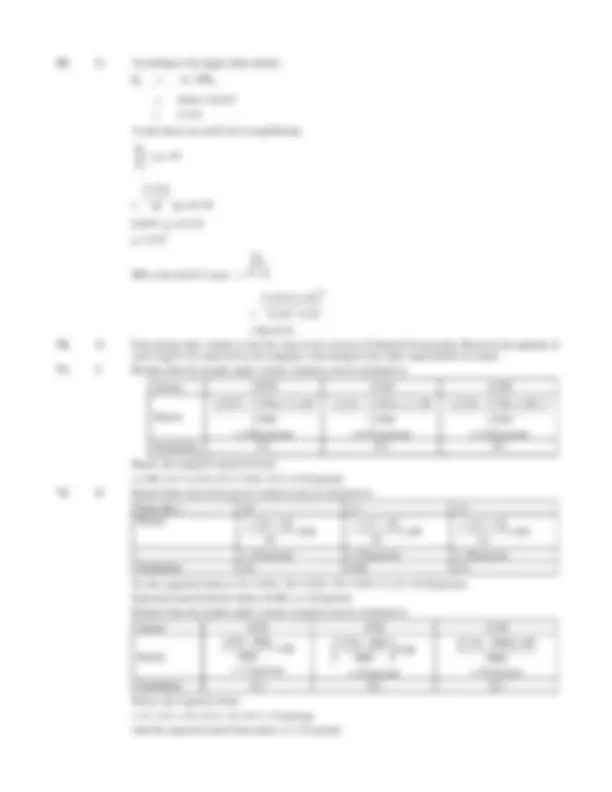
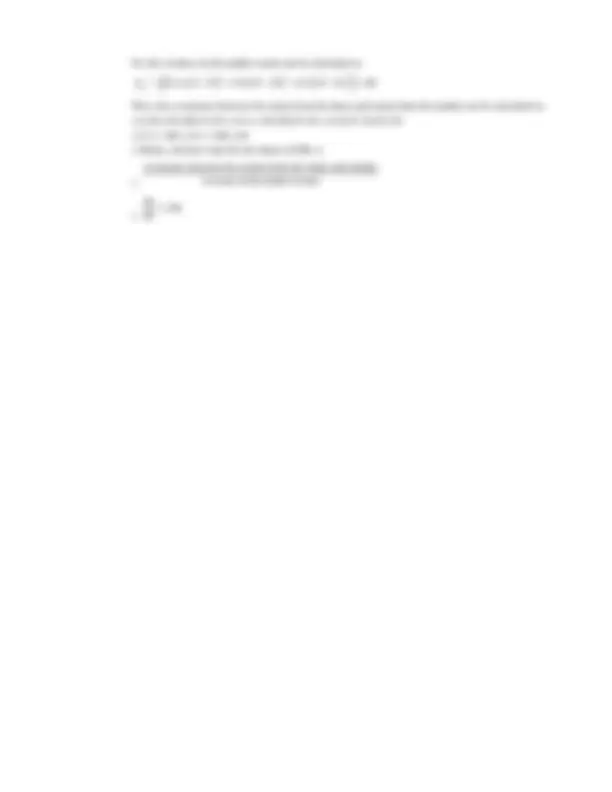


Study with the several resources on Docsity

Earn points by helping other students or get them with a premium plan


Prepare for your exams
Study with the several resources on Docsity

Earn points to download
Earn points by helping other students or get them with a premium plan
Community
Ask the community for help and clear up your study doubts
Discover the best universities in your country according to Docsity users
Free resources
Download our free guides on studying techniques, anxiety management strategies, and thesis advice from Docsity tutors
Financial Management objective type questions and answers.
Typology: Exams
1 / 25

This page cannot be seen from the preview
Don't miss anything!


















(a) LIC (b) SBI Mutual Fund (c) State Bank of India (d) ICICI (e) NABARD. ( 1 mark)
2. (^) Which of the following is not true with regard to valuation of bonds?
(a) An increase in the required rate of return, will decrease the bond value (b) An increase in the number of years to maturity, will increase the present value of the face value of the bond payable at maturity (c) An increase in the coupon rate, will increase the bond value (d) An increase in the face value of the bond payable at maturity, will increase the bond value (e) An increase in yield to maturity will occur if the amount payable at maturity increases, will increase the bond value. ( 1 mark)
3. (^) The doubling period for Kisan Vikas Patra is 7 years and 3 months. The rate of interest that can be calculated from
the rule of 69 is
(a) 9.00% (b) 9.50% (c) 10.00% (d) 10.50% (e) 11.00%. ( 1 mark)
4. (^) The quick ratio is a type of
(a) Liquidity ratio (b) Profitability ratio (c) Leverage ratio (d) Turnover ratio (e) Valuation ratio. ( 1 mark)
5. (^) A type of analysis in which the items of the balance sheet are expressed as percentage of total assets and the items
of the income statement are expressed as percentages of the net sales, is known as
(a) Time series analysis (b) Common size analysis (c) Du Pont analysis (d) Cross-sectional analysis (e) Financial ratio analysis. ( 1 mark)
6. (^) If the debt-equity ratio increases, then the degree of operating leverage
(a) Reduces (b) Increases (c) Remains unchanged (d) Becomes zero (e) Changes unpredictably. (^) ( 1 mark)
7. (^) The Everyman Finance Ltd.(EFL) is offering a deposit scheme in which the investor is required to deposit Rs.
at the end of every month for a period of two years and six months and EFL will pay a sum of Rs.3,500 on the due date. The effective annual rate of return from the above deposit scheme is
(a) 10.00% (b) 12.50%
(c) 14.00% (d) 13.22% (e) 17.50%. ( 2 marks)
8. (^) If the slope of the Security Market Line is zero then, which of the following alternatives is true?
(a) Beta is equal to zero (b) Risk free return = Market return = Expected return of the given security (c) The returns on the given security are not correlated with the returns on the market (d) (^) Risk free rate of return ≠ Market return (e) (^) Market return ≠ Expected return of the given security. ( 1 mark)
9. (^) Given total debt-equity ratio is 5:4; total assets is Rs.4,500; short-term debt is Rs.600 and if total debt consists only
of long-term debt and short-term debt, the long-term debt is equal to
(a) Rs.1, (b) Rs.1, (c) Rs.2, (d) Rs.2, (e) Rs.2,833. ( 1 mark)
10. If the beta of a stock is 1.63 and the standard deviation of the return on the market is 16.25%, then the covariance
of returns of the stock and market is
(a) (^) 99.39%^2 (b) (^) 162.00%^2 (c) (^) 250.02%^2 (d) (^) 430.42%^2 (e) (^) 701.59%^2. (^) ( 1 mark)
11. Rajesh Electricals Ltd. (REL) paid dividend of Rs.3 for the year. The dividend has been growing at a constant rate
of 12%. If the present market price of the stock is Rs.60, the required rate of return on the stock is
(a) 8.20% (b) 12.35% (c) 14.63% (d) 15.28% (e) 17.60%. ( 1 mark)
12. If net profit margin is 10%, asset turnover ratio is 1.2 and return on networth is 18%, then the debt-asset ratio is
(a) 0. (b) 0. (c) 0. (d) 0. (e) 0.72. ( 2 marks)
13. Which of the following is a source of cash, in a funds flow statement drawn on cash basis?
(a) Increase in inventory (b) Decrease in accrued taxes (c) Increase in receivables (d) Repayment of short-term bank loan (e) Increase in accounts payable. ( 1 mark)
14. Which of the following is a non- diversifiable risk?
(a) Lock-out in a company due to workers demanding a wage hike (b) Recession in the economy (c) Lack of strategy for the management of a company (d) A change in the product portfolio of a company (e) Entry of new competitors into the market. ( 1 mark)
15. Which of the following statement(s) is/are true?
I. Current yield is equal to the coupon rate if the market price is equal to the face value of the bond. II. Other things remaining the same, current yield will be higher than YTM if the bond is selling at a premium. III. Other things remaining the same, current yield will be lower than YTM if the bond is selling at a discount.
(a) A sole proprietorship firm is inexpensive to set up (b) Death of one of the partners may result in the dissolution of the partnership firm (c) The minimum number of persons required to form a private company is 2, whereas it is 3 in case of a public company (d) The maximum number of members in a private limited company cannot exceed 50 (e) The ability to raise funds is limited for a partnership firm whereas for a public company it is substantial. (^) ( 1 mark)
22. Which of the following statements is/are (^) true?
I. Other things remaining the same, as the expected growth rate in dividend increases, the expected return depends more on the capital gain yields and less on the dividend yield. II. Other things remaining the same, the price-earning ratio decreases as the expected growth rate in dividend increases. III. High dividend yield and low price-earning ratio imply limited growth prospects.
(a) Only (I) above (b) Only (III) above (c) Both (I) and (III) above (d) Both (II) and (III) above (e) Both (I) and (II) above. ( 1 mark)
23. The face value of the equity share of Blue Sky Ltd. is Rs.100 and the current market price of the share is Rs.80.
The company is expected to declare a dividend of 20% during the current year. If the dividends are expected to decline at the rate of 10% p.a., then, the expected rate of return on the shares is
(a) 8.0% (b) 12.5% (c) 17.5% (d) 32.0% (e) 37.5%. ( 2 marks)
24. Consider the following information:
Quantity produced – 1,000 units Variable cost per unit – Rs.47, Selling price per unit – Rs.60, Fixed cost – Rs.50 lakh Interest – Rs.20 lakh Preference dividend – Rs.15 lakh Tax rate – 40%
The financial break even point is reached when the EBIT is at a level of
(a) Rs.20 lakh (b) Rs.35 lakh (c) Rs.45 lakh (d) Rs.50 lakh (e) Rs.75 lakh. ( 2 marks)
25. Which of the following is/are statistical method (s) of sales forecasting?
I. Jury of executive opinion. II. Sales force estimates. III. Regression analysis. IV. Trend analysis.
(a) Only (II) above (b) Both (I) and (II) above (c) Both (II) and (III) above (d) Both (III) and (IV) above (e) (I), (III) and (IV) above. ( 1 mark)
26. The projected returns from the shares of Smitha Industries Ltd. (SIL) and the returns from the market portfolio
with their probability are given below:
Probability
Returns (%) SIL share Market portfolio
The risk of the SIL share is
(a) 5.026% (b) 7.115% (c) 8.307% (d) 15.118% (e) 82.010%. ( 2 marks)
27. Which of the following is true with respect to Commercial Papers (CPs)?
(a) These are issued in multiples of Rs.1 lakh (b) The minimum amount to be invested by a single investor is Rs.5 lakhs (c) The minimum maturity period is 30 days (d) The issuer cannot buy back these instruments (e) These can be raised upto the extent of 80% of working capital limit. ( 1 mark)
28. If the net profit margin is 8%, retention ratio is 60%, asset to equity ratio is 1.5 and sales turnover ratio is 0.75, the
rate of sustainable growth with internal equity will be
(a) 3.47% (b) 3.73% (c) 5.12% (d) 5.71% (e) 6.84%. ( 2 marks)
29. Mr. Chokalingam wishes to purchase a 364 day T-bill of face value Rs.100, maturing after 160 days. If,
Mr.Chokalingam wants to earn a yield of 9.5%, the purchase price for him should be
(a) Rs.90. (b) Rs.91. (c) Rs.94. (d) Rs.96. (e) Rs.96.50. ( 1 mark)
30. In which of the following types of issues, does the amount of share capital increase without an increase in the
networth of the company?
(a) Public issue (b) Rights issue (c) Bought-out deal (d) Bonus issue (e) Private placement. ( 1 mark)
31. If the current assets and current liabilities are Rs.1,500 lacs and Rs.1,200 lacs respectively, the amount of short-
term borrowings that has to be repaid to increase the current ratio to 1.5 is
(a) Rs. 50 lakh (b) Rs.100 lakh (c) Rs.125 lakh (d) Rs.150 lakh (e) Rs.200 lakh. ( 1 mark)
32. The inventory turnover ratio of M/s Jaina Automobiles Ltd. is 5 times and cost of goods sold is Rs.5,50,000 per
annum. If the opening stock is Rs.120,000, the closing stock is
(a) Rs. 80, (b) Rs. 90, (c) Rs.1,00, (d) Rs.1,20, (e) Rs.1,80,000. ( 2 marks)
33. The capital structure of Eastern Industries Ltd. (EIL) consists of the following:
(Rs. in crore)
(c) Rs.20 lakh (d) Rs.25 lakh (e) Rs.50 lakh. ( 1 mark)
39. In which of the following conditions will the degree of total leverage of a firm be zero?
(a) The firm has no debt (b) The firm has redeemed all the preference shares issued by it (c) The sales revenues of the firm are just enough to meet the variable expenses (d) The earnings of the firm are exempt from tax (e) The fixed cost of the firm is equal to its contribution. (^) ( 1 mark)
40. Santhosh Pharma Ltd. recently issued preference shares to redeem its outstanding debentures. The rate of
preference dividend is same as the coupon rate on the debentures. How will the Degree of Financial Leverage (DFL) of the firm be affected?
(a) It will increase (b) It will decrease (c) It will remain constant (d) It will become zero (e) The effect on DFL cannot be predicted. ( 1 mark)
41. The Fair And Smile Ltd. issued debentures with face value Rs.100 at a coupon rate of 10 percent payable semi-
annually. The debenture will be redeemed in two equal annual installments; the first installment will be payable at the end of five years and six months from now, and the second installment will be payable at the end of six years and six months from now. Ms. Julie wants to buy the debenture and her required rate of return is 12%. What is the fair price for which she can buy the debenture?
(a) Rs. 90. (b) Rs. 91. (c) Rs. 92. (d) Rs. 97. (e) Rs.102.64. ( 2 marks)
42. Which of the following is true?
(a) Effective rate of interest is always lower than the nominal interest rate (b) The effective rate of interest increases with increase in the frequency of compounding (c) The nominal interest rate increases with increase in the frequency of compounding (d) The effective and nominal interest rates are equal if the frequency of compounding is less than 4 (e) The frequency of compounding does not affect the effective and nominal interest rates. ( 1 mark)
43. Who among the following players in the international capital markets collect the rupee dividends on the underlying
shares and repatriate the same to the depository in US dollars/foreign equity?
(a) Lead Managers (b) Underwriters (c) Custodian (d) Corporate borrowers (e) Lenders. ( 1 mark)
44. Which of the following will decrease with an increase in the interest rate?
(a) Future Value Interest Factor (b) Future Value Interest Factor For Annuity (c) Capital Recovery Factor (d) Present Value Interest Factor for a perpetual annuity (e) Inverse of Present Value Interest Factor For Annuity. ( 1 mark)
45. M/s Nagarjuna Chemicals Ltd. is able to sell their securities in the secondary market only with substantial price
concession. The risk associated with the security can be termed as
(a) Interest rate risk (b) Market risk (c) Business risk (d) Financial risk (e) Liquidity risk. ( 1 mark)
46. Which of the following euro instruments is a medium-term legally binding commitment under which a borrower
can issue short-term paper, of up to one year?
(a) Note Issuance Facilities (NIFs) (b) Commercial paper (c) Straight debt bonds (d) Floating Rate Notes (FRNs) (e) Medium-term notes. ( 1 mark)
47. Sterling denominated foreign bonds raised in the United Kingdom’s domestic securities market is known as
(a) Samurai Bonds (b) Yankee Bonds (c) Bulldog Bonds (d) Shibosai Bonds (e) Matador Bonds. ( 1 mark)
48. M/s. Adarsh Finance Ltd. has outstanding equity share capital of Rs.2 lakh of face value Rs.20 per share. The net
income of the company for the year is Rs.50,000. If the dividend pay-out (DP) ratio is 40% and the market price of the share is Rs.50, the dividend yield is
(a) 4% (b) 8% (c) 10% (d) 12% (e) 16%. (^) ( 1 mark)
49. The probability distribution of returns of stock of M/s. Arundhathi Ltd. and the returns on market are given below:
The variance associated with the market returns is 10.6875(%)^2. The risk-free rate of return is 6%. According to CAPM, the risk premium for the stock of M/s. Arundhathi Ltd. is
Probability (P)
Returns of stock of M/s. Arundhathi Ltd. (in %)
Market returns (in %)
(a) 1.77% (b) 2.43% (c) 2.56% (d) 2.72% (e) 3.39%. ( 2 marks)
50. Mr. Vaibhav purchased a coupon-bearing debenture of the face value Rs.100 for Rs.110. After one year he sold the
security for Rs.115. If the holding period return on this debenture is 15%, the annual amount of coupon received on the debenture is
(a) Rs. 5. (b) Rs. 8. (c) Rs. 9. (d) Rs.10. (e) Rs.11.5. ( 2 marks)
51. Consider the following particulars of Murugan Spares Ltd. The average collection period is 60 days and the
average accounts receivables of the company is Rs.45,000. The annual sales for the company, assuming 360 days in a year, is
(a) Rs.2,40, (b) Rs.2,70, (c) Rs.2,82, (d) Rs.3,15, (e) Rs.3,40,000. ( 1 mark)
52. M/s. Ammolya Ayurveda Pharmaceuticals Ltd. issued par value bonds of Rs.1,000 each with maturity value of
(e) Rs.7.25 lakhs. ( 2 marks)
58. M/s. Gwalior Textiles Ltd. issued fully convertible debentures of face value Rs.100 each with a coupon rate of
10% p.a. The debentures will be converted into 2 equity shares of Rs.50 each at the end of one year. If the expected share price at the end of one year is Rs.60 and the required rate of return is 15%, the value of convertible is (correct to rupee)
(a) Rs. 98 (b) Rs. 113 (c) Rs. 116 (d) Rs. 125 (e) Rs. 142. ( 2 marks)
59. Consider the following data regarding M/s. Surya Ltd. for the year 2007-08:
Cost of goods sold : Rs.39,00, Gross profit margin : 25% Average receivables turnover ratio : 5 Quick assets : Rs.18,00,
The cash balance is (Assume the entire sales as on credit)
(a) Rs. 2,75, (b) Rs. 7,60, (c) Rs. 9,20, (d) Rs.10,40, (e) Rs.10,70,000. (^) ( 2 marks)
60. Which of the following statements is (^) true , in case of a direct quote?
(a) Exchange margin is to be added to the bid rate and ask rate (b) Exchange margin is to be added to the bid rate and deducted from the ask rate (c) Exchange margin is to be deducted from the bid rate and the ask rate (d) Exchange margin is to be deducted from the bid rate and added to the ask rate (e) Exchange margin is to be added to the bid rate only. ( 1 mark)
61. Ms. Renuka places an order with a broker in the stock exchange to sell 500 shares of
Manyata Ltd. at a minimum price of Rs.215 per share including brokerage charges of 1%. Such an order is referred to as
(a) Limited discretionary order (b) Best rate order (c) Immediate order (d) Limit order (e) Stop loss order. (^) ( 1 mark)
62. While preparing Fund Flow Statement on total resources basis, the fund from operation is to be computed. In this
aspect which of the following item is to be deducted from the net profit?
(a) Preliminary expenses written off (b) Transfer to reserves (c) Proposed dividends (d) Profit on sale of investments (e) Loss on sale of fixed assets. ( 1 mark)
63. Which of the following cannot be inferred from a funds flow analysis?
(a) Liquidity (b) Acquisition of non current assets (c) External funds utilized (d) Pattern of financing (e) Management quality. ( 1 mark)
64. Oriental Spices and Exports Ltd. presently pays a dividend of Rs.3 per share. The dividend is expected to grow at
the rate of 4% for the next four years and then at a constant rate of 3% for ever. If the required rate of return is 10% and the holding period infinite, the value of share one can pay now is
(a) Rs.10. (b) Rs.35.
(c) Rs.45. (d) Rs.51. (e) Rs.55.68. ( 2 marks)
65. The current assets and liabilities of Swaraj Industries Ltd. are Rs.100 lakh and Rs.60 lakh respectively. During the
current year fixed assets worth Rs.20 lakh are purchased, new shares are issued for Rs.25 lakh, bills receivable worth Rs.2,00,000 are dishonored and Rs.3,00,000 cash is collected from customers. The current ratio will
(a) Increase to 1. (b) Decrease to 1. (c) Increase to 1. (d) Decrease to 1. (e) Have no change. ( 1 mark)
66. Consider the following data regarding M/s.Neeraj Distilleries Ltd. for the year 2007-2008:
Funds from operations of M/s. Neeraj Distilleries Ltd. during the year was
Particulars Rs.lakhs Retained earnings 40 Interest earned on investments 12 Amortization of copy rights written off 10 Depreciation 8 Dividends 20 Preliminary expenses written off 10
(a) Rs. 40 lakhs (b) Rs. 42 lakhs (c) Rs. 76 lakhs (d) Rs. 82 lakhs (e) Rs.100 lakhs. ( 2 marks)
67. The Sabari Power Projects Ltd. issued bonds with the following features to finance its new project in Kerala:
Face value of the bond Rs.5, Coupon per annum 10% Issued at a discount of 10% Redemption at a premium of 5%.
Mr. Hariharan purchased the bond from the secondary market. If the current yield of the bond is 8.33%, it is trading at a
(a) Discount of 12% (b) Discount of 16.67% (c) Premium of 20% (d) Premium of 16.67% (e) Premium of 30%. ( 2 marks)
68. Seven Seas Investment Corporation holds the following portfolio:
The required rate of return on the market is 14% and that of the above portfolio according to CAPM is 20.4%. The fund manager has proposed to sell stock of Chathuri Ltd. for Rs.200 crores and use the proceeds to purchase stock of Devaki Ltd. which has a beta of 3. The required rate of return of the new portfolio according to CAPM is
Stock Investment (Rs. Crores) Beta Arati Ltd. 400 0. Bharati Ltd. 400 2 Chathuri Ltd. 200 4
(a) 12.8% (b) 18.1% (c) 18.8% (d) 20.2% (e) 21.3%. ( 2 marks)
69. Ms. Lovely is considering investing in the equity shares of Confident Smile Tooth Paste Limited. She gathers the
following information on the equity shares of the company:
1. C Commercial banks can act both as lenders and borrowers in the call money market but the financial institutions like LIC, mutual funds, ICICI, and NABARD can act only as lenders in the market 2. B In the intrinsic value formula the face value of the bond is multiplied with the factor PVIF(r,n). The factor PVIF(r,n) decreases as the number of years to maturity increases, other things remaining the same. Hence, other things remaining the same, the present value of the face value of the bond decreases as the number of years to maturity increases. Therefore alternative (b) is not true. All other alternatives are true 3. C According to the rule of 69, the doubling period = 0.35 +
Doubling period of Kisan Vikas Patra = 7 years + 3 months
= 7 + = 7.25 years.
or 6.9 =
or interest rate = = 10%
interest rate
interest rate
interest rate
4. A Quick ratio is a type of Liquidity Ratio. It is the ratio of current assets excluding inventory to current liabilities. 5. B The Common-size Analysis in used to find out the proportion that a single item represents of total group or sub-group. In a Balance Sheet, the assets as well as liabilities and capital are expressed as 100 per cent and each item in these categories is expressed as a percentage of the respective totals .Similarly, in the income statement, net sales are set at 100 per cent and every other item in the statement is expressed as a percentage of net sales. 6. C Degree of operating leverage (DOL)
= (Sales – Variable costs) ÷ (Sales – Variable costs – Fixed costs) The variable and fixed costs do not include any financial costs. Hence the DTL remains unchanged if the debt-equity ratio increases
7. D^ Amount to be deposited at the end of every month = Rs.
Number of months for which money has to be deposited = 2 × 12 + 6 = 30 Maturity value = Rs. Therefore 100 x FVIFA (K,30) = 3500 at 1% LHS = Rs. 3478. at 1.5% LHS = Rs. 3753.
By inter proration =
i = 1.04%.
The effective annual rate of return is
8. B According to the SML equation:
kj = Rf + βj (km – Rf)
The slope is (km – Rf). When the slope is zero, kj = Rf + 0 = Rf
Further, km – Rf = 0 implies that km = Rf
∴Rf = km = kj
i.e. Risk free rate of return = Market return = Expected return of the given security
9. B
= Adding 1 to both sides of the equation we get:
From above, Equity = = = Rs.2,
Now, total assets = Total debt + equity = Rs.4,500 or or, Total debt + 2000 = 4500 or or, Total debt = 4500 – 2000 = Rs.2, ∴Long term debt = Total debt – Short term debt = 2500 – 600 = Rs.1,900.
Equity
Totaldebt
4
Equity
Totaldebt
4
Equity
Total debt+equity
4
Equity
Totalasset
4
Total asset× 4 9
β =
or, = 1.63 (16.25)^2 = 430.42%^2
2 m
Cov(i,m )
σ
Cov β.α^2 (im) = m
Required rate of return on the stock = = + g = + 0.
= 0.176 i.e. 17.6%
g P
0
0
0 P
D ( 1 + g) 3(1.12)
60
Return on net worth = Net profit margin × Asset turnover ×
or 0.18 = 0.10 × 1.2 ×
or = = 1.
Equity
Assets
Equity
Assets
Equity
Assets 0. 0.10 ×1.
Assets
Equity
Assets
Equity Assets
Assets −Equity Assets
Debt
13. E Alternatives, (a), (b), (c) and (d) represents uses of cash. Alternative (e) i.e increase in accounts payable is a source of cash in the fund flow statements drawn on cash basis. 14. B Alternatives (a), (c), (d) and (e) represent risk factors which are specific to the firm and can be diversified away. Recession in the economy is not a firm specific risk, hence, it is a non-diversifiable risk.
Current yield =
Coupon rate =
When current yield and coupon rates are same, the market price of the bond is equal to its face value. Hence statement (I) is true. When the bond is selling at a premium the current yield will be higher than the
Market price
Couponamount
Face value
Couponamount
P 0 = Current market price
ke = Expected rate of return
g = Growth rate in dividends
D 1 = Dividend at the end of one year.
The above equation can be rewritten as:
ke =
Putting the values for the variables we get:
ke = =
= 0.125 i.e., 12.5%.
g P
0
Financial break even point = EBIT = I +
Where, I = Rs.20 lakh DP = Rs.15 lakh t = 40%
∴ In this case, at financial break even point EBIT = =Rs.45 lakh.
1 t
25. D (I) and (II) are subjective methods of sales forecasting and (III) and (IV) are statistical methods. Hence answer (d) is correct. 26. C SIL shares:
Expected return = Σpiki = 10 (0.30) + 20 (0.30) + 30 (0.40)
= 3+6+12=21%
Risk = Standard deviation of returns =
= [(10 – 21)^2 (0.30) + (20 – 21)^2 (0.30) + (30 – 21)^2 x 0. = [69]1/ = 8.307%.
21 /^2 Σp (^) i (ki−ki)
27. B Commercial papers are short term, unsecured promissory notes issued by corporates which are financially strong and have high credit rating. The minimum amount to be invested by a single investor is Rs.5 lakhs. Hence, the answer is (b). These instruments are issued in multiples of Rs.5 lakhs. Hence, (a) is not correct. The maturity period varies from 15 days to a year. Hence, (c) is not correct. Unlike certificate of deposits, CPs can be bought back by the issuers. Hence, (d) is not correct. The companies can raise commercial papers upto the extent of 100 percent of the working capital limit. Hence, (e) is not correct. 28. D Sustainable growth rate (g)
g = where, m is net profit margin = 8%, d is dividend payout ratio = 40%
Asset to equity ratio, = 1.
o
m(1 d) E A A m(1 d) S E
Assets to sales ratio ( ) =
g = = 0.0571 = 5.71%
o
Yield is calculated as
Where, F is face value P is purchase price d is the duration/maturity period
In the given case, yield =
If yield = 9.5%, P is calculated as,
P = Rs.96.
d
30. D Some companies distribute profits to the existing shareholders by way of fully paid bonus shares in the ratio of existing shares held. In this method of issue though the amount of share capital is increased there will not be any increase in the networth because it is just conversion of eligible reserves into share capital. Hence, (d) is the answer. Public issue is the method of raising capital from the public. In this method there will be an equal increase in the share capital and networth of the company. Rights issue is the method of raising capital from the existing members by offering shares to them on pro-rata basis. This method also results in an increase in share capital and networth of the company. Bought out deals is the method of raising capital by a company by initially placing its shares, which are to be offered to the public at a later date, to a merchant banker, who in turn off loads the shares at the appropriate time. In this method too, share capital and inturn networth of the company are increased by the issue amount. Private placement, the method raising capital from a limited number of sophisticated investors, also results in increase in share capital and networth of the company. Hence, (a), (b), (c) and (e) are not the answers. 31. E Current ratio =
or,
or, = Rs. 1000 lakhs
As the existing current liabilities amount to Rs.1200 lakhs, Rs.200 lakhs of short term borrowings have to be repaid to increase the CR to 1.5.
Inventory turnover = Averagestock
Costofgoodssold
37. A The present liquidity position of a company is assessed by using its liquidity ratio. The long-term solvency of the firm is assessed through the capital structure ratios while the effectiveness of the utilization of the assets is done through the assets turnover ratios. Profitability is examined by using the profitability ratios like net profit margins, return on networth, etc. whereas the efficiency of the collection of the receivables is assessed by the average collection period. 38. E Change is net working capital can be calculated as : (100 +60 +25 – 35) –(80 + 50 +10 – 40)
= 150 – 100 = Rs.50 lakh
39. C
Degree of Total Leverage (DTL) =
Hence, the sales revenue of the firm is Q.S while the total variable expenses is =Q.V Now, if QS = QV, DTL will be zero
P
Degree of Financial Leverage (DFL) =
Now, as the coupon rate of the debentures and preference shares is same, so I = Dp
But interests on debentures are a pre-tax expense while the dividend on preference share is a post-tax expense. As the tax rate T>O, the DFL of the company will increase as the negative part of the denominator increases.
p
41. B The cash flow pattern for the debentures will be as follows:
Half-yearly coupon payment = Rs.5 each upto five years and six months, and then a coupon amount of Rs. 2.5 each at the end of 6 years and at the end of 6 years and 6 months. Redemption payment = Rs.50 each at the end of 5 years and 6 months, and at the end of 6 years and 6 months. The fair price of the debenture (Po) = 5PVIFA (6%,11) +50PVIF(6%,11)+2.5PVIF(6%,12) + 52.5PVIF (6%,13). =5x7.8869+50x0.5268+2.5x0.4970+52.5x0. =Rs.91.
42. B The interest rate usually specified on an annual basis in a loan agreement or security is known as the nominal rate of interest. If compounding is done more than once a year, the actual rate of interest paid (or received) is called effective interest rate. Effective interest rate would be higher than the nominal interest rate. The effective rate of interest increases with increase in the frequency of compounding. For example, the effective rate of interest under quarterly compounding will be more than the effective rate of interest under semi-annual compounding. Hence option (b) is correct. 43. C Custodians hold the underlying shares and collect rupee dividends on the underlying shares and repatriate the same to the depository in US dollars/foreign equity. Hence (c) is the answer. Lead managers undertake activities like preparation of offer circular, marketing the issues etc. Underwriters of the issue bear interest rate or market risks moving against the issuer before they have placed bonds or depository receipts. 44. D Present value factor for a perpetual annuity =. Hence it decreases with an increase in the interest rate. Hence (d) is the correct option.
Future Value Interest Factor =. Hence it increases with increase in the interest rate.
Future Value Interest Factor For Annuity (FVIFA) =. FVIFA also increases with increase in the interest rate.
i
(1 +i)^ n
(1 i)^ n 1 i
Capital Recovery Factor =. It is the inverse of PVIFA, which decreases with increase in interest rate. Therefore, Capital Recovery Factor increases with increase in the interest rate. Inverse of PVIFA is capital recovery factor, which increases with increase in the interest rate. Hence, options (a), (b), (c) and (e) are incorrect.
n n
i(1 i) (1 i) 1
45. E Liquidity risk is the risk associated with the secondary market in which the security is traded. The greater the uncertainty about the time element and the price concession, the greater is the liquidity risk. Hence (e) is the answer. Interest rate risk is the variability in a security’s return resulting from changes in the level of interest rates. Market risk refers to the variability of returns due to fluctuations in the securities market. Business risk is the risk of doing business in a particular industry or environment. Financial risk is the risk that arises when companies resort to financial leverage or the use of debt financing. 46. A Note Issuance Facility (NIF) is a medium-term legally binding commitment under which a borrower can issue short-term paper, of upto one year. Hence (a) is the answer. Commercial papers are short-term unsecured promissory notes, which pay a fixed amount. Straight debt bonds and floating rate notes are long-term instruments having a maturity of over one year. 47. C Bulldog bonds are sterling denominated foreign bonds which are raised in the United Kingdom domestic securities market. Hence option (c) is the correct choice. Samurai bonds are bonds issued by non-Japanese borrowers in the domestic Japanese markets. Yankee bonds are US dollar denominated bonds issued by foreign borrowers in the US domestic markets. Shibosai Bonds are Yen denominated privately placed bonds issued in the Japanese Markets. Matador bonds are foreign bonds issued in Spain.
Dividend yield =
Dividend per share Market price per Share
Net Income x Payout ratio 1 x No. of shares MP
50,000 x 0.4 1 x 0.04 4% 10,000 50
49. B (^) Risk premium = β(Rm – Rf)
Risk premium = 0.884 (8.75 – 6) = 2.43%. Hence, option (b) is the correct choice.
Prob. kA km
(kA- )
(km- )
(kA- ). P
k (^) A = (^) ∑ k PA =8.
k (^) m = (^) ∑ k Pm
Cov(k (^) Ak (^) m)
Var(k (^) m)
P .(k (^) A k (^) A )(k (^) m k (^) m)
P(k k )^2 m m
Return on debenture = PurchasePriceat thebeginningoftheyear
Coupon payment+Appreciationin theprice